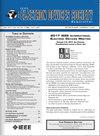Device Modeling Based on Cost-Sensitive Densely Connected Deep Neural Networks
IF 2
3区 工程技术
Q3 ENGINEERING, ELECTRICAL & ELECTRONIC
引用次数: 0
Abstract
Engineers used TCAD tools for semiconductor devices modeling. However, it is computationally expensive and time-consuming for advanced devices with smaller dimensions. Therefore, this work proposes a machine learning-based device modeling algorithm to capture the complex nonlinear relationship between parameters and electrical characteristics of gate-all-around (GAA) nanowire field-effect transistors (NWFETs) from technology computer-aided design (TCAD) simulation results. This method utilizes a densely connected deep neural networks (DenseDNN), which establishes direct connections between layers in the neural networks, provides stronger feature extraction and information transmission capabilities. By incorporating cost-sensitive learning methods, the proposed model focus more on the critical data that determines device characteristics, leading to accurate prediction of key device characteristics under various parameters. Experimental results on a test dataset of 116 NWFETs demonstrate the effectiveness of this method. The DenseDNN model with cost-sensitive learning exhibits better performance than traditional deep neural networks (DNN) with various widths and depths, with a prediction error below 1.62%. Moreover, compared to TCAD simulation results, the model can speedup基于成本敏感型密集连接深度神经网络的设备建模
工程师使用 TCAD 工具进行半导体器件建模。然而,对于尺寸较小的先进器件来说,这种方法计算成本高且耗时。因此,本研究提出了一种基于机器学习的器件建模算法,以从技术计算机辅助设计(TCAD)仿真结果中捕捉全栅极(GAA)纳米线场效应晶体管(NWFET)参数与电气特性之间复杂的非线性关系。该方法利用密集连接的深度神经网络(DenseDNN),在神经网络各层之间建立直接连接,提供更强的特征提取和信息传输能力。通过采用对成本敏感的学习方法,所提出的模型更加关注决定设备特性的关键数据,从而在各种参数下准确预测关键设备特性。在 116 个 NWFET 测试数据集上的实验结果证明了该方法的有效性。与具有不同宽度和深度的传统深度神经网络(DNN)相比,具有成本敏感学习的 DenseDNN 模型表现出更好的性能,预测误差低于 1.62%。此外,与 TCAD 仿真结果相比,该模型的速度提高了 10^{6}/times$ 。
本文章由计算机程序翻译,如有差异,请以英文原文为准。
求助全文
约1分钟内获得全文
求助全文
来源期刊

IEEE Journal of the Electron Devices Society
Biochemistry, Genetics and Molecular Biology-Biotechnology
CiteScore
5.20
自引率
4.30%
发文量
124
审稿时长
9 weeks
期刊介绍:
The IEEE Journal of the Electron Devices Society (J-EDS) is an open-access, fully electronic scientific journal publishing papers ranging from fundamental to applied research that are scientifically rigorous and relevant to electron devices. The J-EDS publishes original and significant contributions relating to the theory, modelling, design, performance, and reliability of electron and ion integrated circuit devices and interconnects, involving insulators, metals, organic materials, micro-plasmas, semiconductors, quantum-effect structures, vacuum devices, and emerging materials with applications in bioelectronics, biomedical electronics, computation, communications, displays, microelectromechanics, imaging, micro-actuators, nanodevices, optoelectronics, photovoltaics, power IC''s, and micro-sensors. Tutorial and review papers on these subjects are, also, published. And, occasionally special issues with a collection of papers on particular areas in more depth and breadth are, also, published. J-EDS publishes all papers that are judged to be technically valid and original.
 求助内容:
求助内容: 应助结果提醒方式:
应助结果提醒方式:


